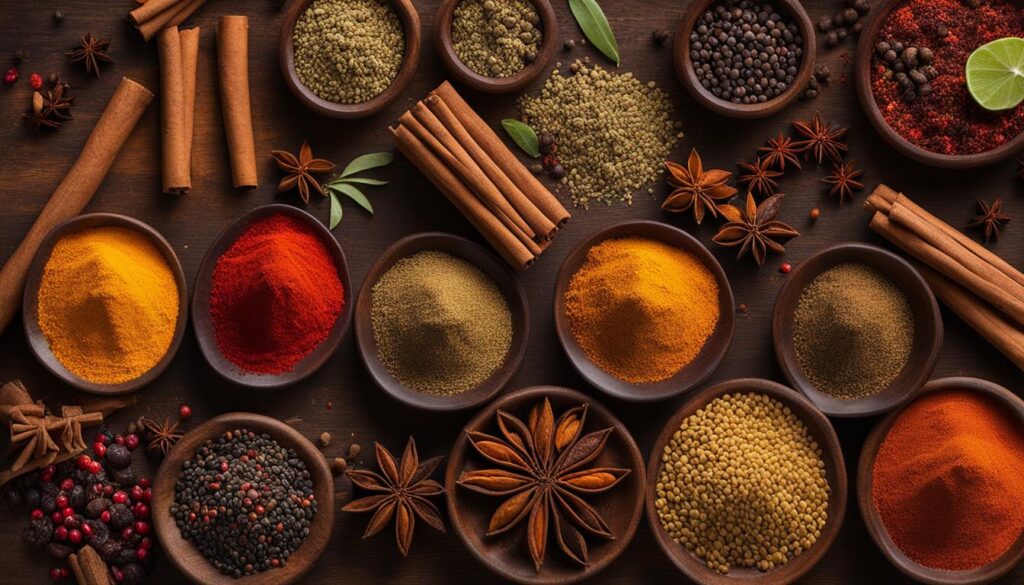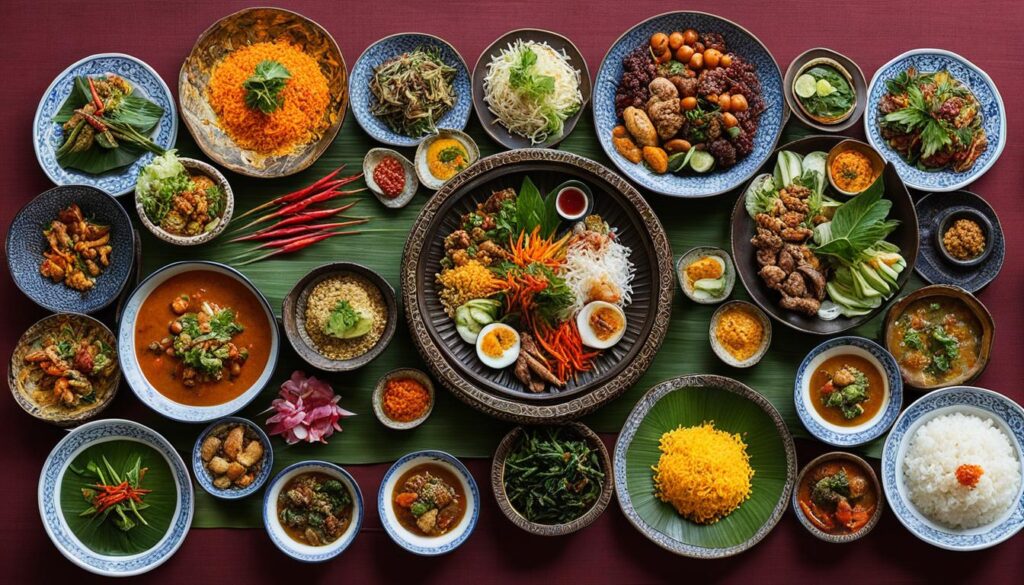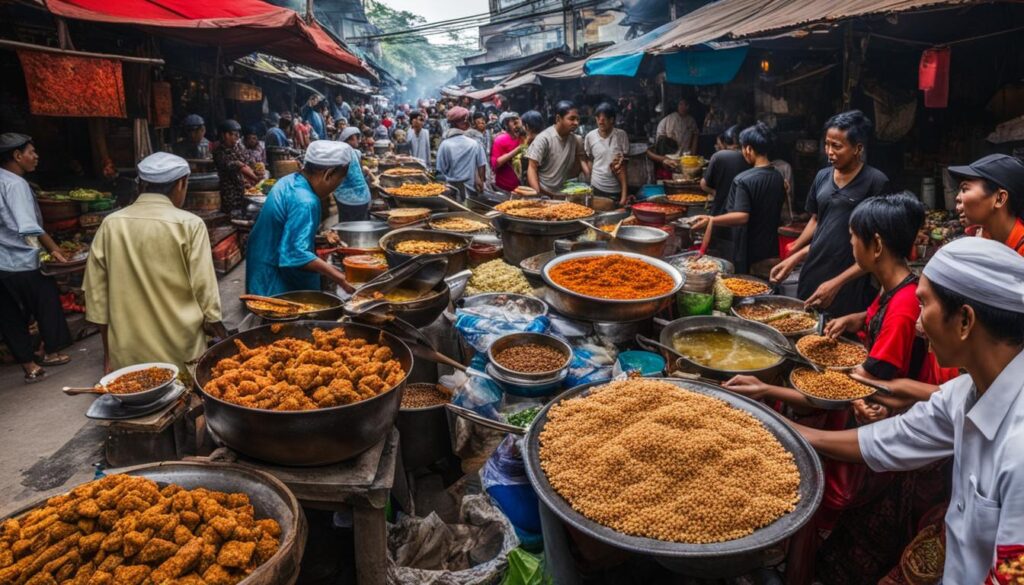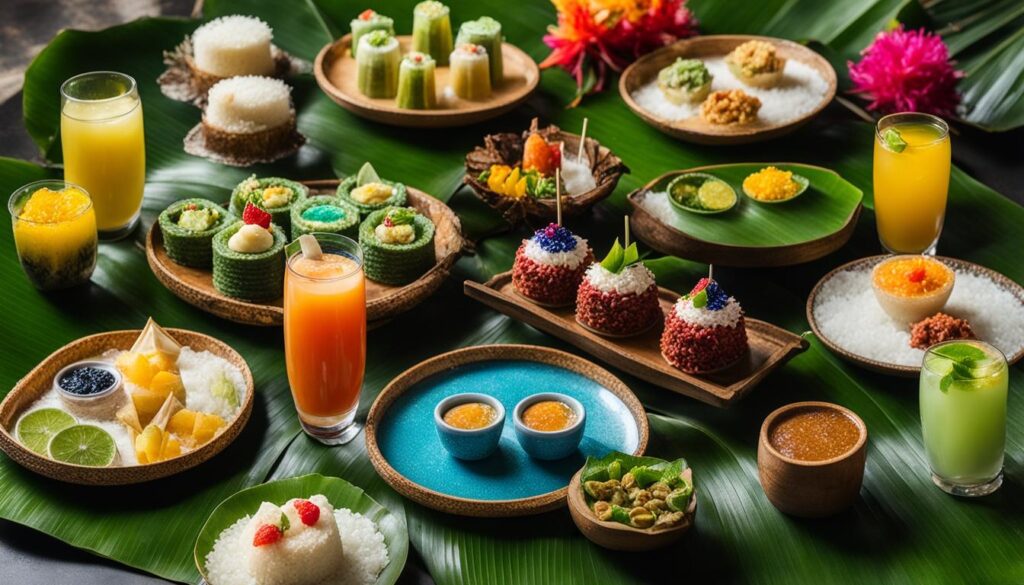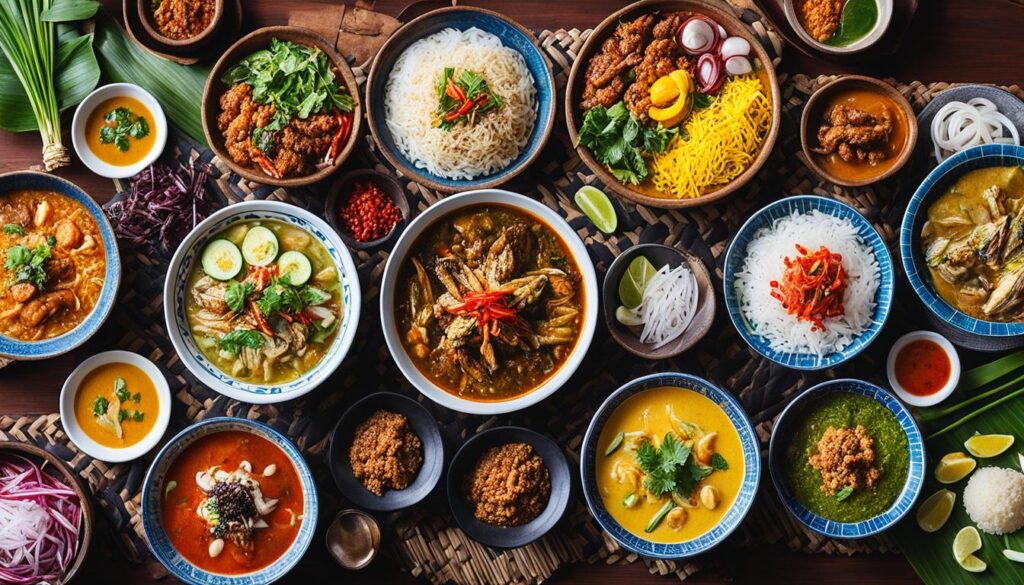If you think Javanese cuisine is all about gudeg and sate klathak, you’re missing out on a world of culinary delights.
Javanese food is known for its rich and diverse flavors, thanks to the use of aromatic spices, fresh ingredients, and unique cooking techniques. In this article, we’ll explore the lesser-known traditional Javanese dishes that go beyond the classics and uncover the richness of Javanese gastronomy.
From street food delights and refreshing drinks to regional specialties and fusion cuisine, there’s so much to discover about Javanese food. Whether you’re a foodie or just looking to expand your palate, buckle up and get ready for a culinary journey like no other.
Uncover the Rich Diversity of Javanese Flavors
Javanese cuisine exploration is a journey into the heart and soul of Indonesia’s culinary diversity. The gastronomy is characterized by unique spices and cooking techniques that elevate it to an exotic class of its own. The use of aromatic spices such as turmeric, coriander, and galangal is a trademark of Javanese food, enhancing the taste and flavor of every dish. Fresh ingredients like lemongrass, lime leaves, and torch ginger flower are also widely used to add zing and a refreshing flavor to the food.
Did you know? Javanese cuisine is famous for its use of peanuts. Many dishes, including sate kambing and gado-gado, are served with peanut sauce, blended with a mix of spices and chili to give it a distinct, fiery flavor that is hard to resist.
Javanese gastronomy is a reflection of the diverse communities and cultures found in the region. Every sub-region has its own specialty dishes that reflect its unique history, customs, and traditions. Central Javanese cuisine, for instance, is known for its spicy dishes, such as opor ayam, a chicken curry featuring a fragrant mixture of turmeric, coriander, lemongrass, and galangal. Meanwhile, coastal Javanese cuisine features an array of seafood delights, from grilled fish to spicy shrimp dishes.
Tip: To experience the rich diversity of Javanese flavors, try different dishes from across the region. The Javanese culinary experience is all about exploring and discovering new dishes.
The cooking techniques used in Javanese cuisine are also worth noting. Many dishes are slow-cooked over a wood fire, giving them a smoky, flavorful taste. The use of banana leaves to wrap food, such as nasi liwet and ayam ingkung, is another unique feature of Javanese cooking that adds a distinctive aroma to the food.
Javanese Flavors: A Summary
| Feature | Description |
|---|---|
| Aromatic Spices | Use of spicesturmeric, coriander, and galangal, among othersfor flavor enhancement |
| Fresh Ingredients | Use of lemongrass, lime leaves, and torch ginger flower to add zing and refreshing flavors |
| Regional Variations | Central Javanese cuisine is known for spicy dishes; coastal Javanese cuisine features an array of seafood dishes |
| Unique Cooking Techniques | Slow-cooking over a wood fire and use of banana leaves to wrap food for a smoky, distinctive taste |
Traditional Javanese Dishes: Beyond the Classics
When it comes to exploring the authentic Javanese cuisine, there’s much more to taste beyond the popular dishes like gudeg and sate klathak. Javanese culinary delights offer a variety of traditional dishes that are lesser-known but equally delicious. Here are some authentic Javanese recipes that you can try:
| Dish | Ingredients |
|---|---|
| Nasi Liwet | Rice, coconut milk, bay leaves, lemongrass, shallots, garlic, candlenuts, salt, pepper, water |
| Pecel Lele | Fried catfish, peanut sauce, vegetables like lettuce, cucumber, bean sprouts, and basil leaves |
| Tengkleng Kambing | Goat meat, cow bones, kecap manis, shallots, garlic, bay leaves, lemongrass, galangal, turmeric, salt, pepper, lime leaves |
These traditional Javanese dishes are usually served with a side of steamed white rice and sambal or spicy condiment. They represent the unique flavors and cooking techniques that make Javanese food distinctive from other Indonesian cuisines.
If you’re looking to add some authentic Javanese recipes to your cooking repertoire, try out these lesser-known dishes.
Indulge in Javanese Street Food Delights
When in Java, there’s no better way to immerse yourself in the local culture than by trying out some of the street food. Javanese street food is an experience in and of itself, with unique flavors and textures that tantalize your taste buds. From savory snacks to sweet treats, street food offers a glimpse into everyday life in Java.
Some of the most popular street food items include:
| Food Item | Description |
|---|---|
| Klepon (SEO keyword: Authentic Javanese cuisine) | A traditional sweet snack made of glutinous rice flour filled with palm sugar and coated with grated coconut. |
| Tempe Mendoan (SEO keyword: Javanese food) | Thinly sliced tempeh battered with flour and spices and fried to crispy perfection. |
| Bakso (SEO keyword: Javanese food) | Meatballs made of minced beef, chicken, or fish served in a flavorful broth with noodles and vegetables. |
Street food in Java is not just about the food itself, but also about the experience. Often, vendors set up their carts along the roadside or in bustling markets, creating a lively and colorful atmosphere. Grab a plate of your favorite street food, find a spot to sit, and savor the flavors and energy of Javanese street life.
“Trying out Javanese street food will undoubtedly spice up your culinary adventure in Java.”
Authentic Javanese Drinks and Desserts
Javanese cuisine is not only renowned for its rich and diverse flavors but also for its refreshing drinks and delectable desserts. Experience the quintessential taste of Java by indulging in these traditional beverages and sweet treats.
| Drinks | Description |
|---|---|
| Jamu | A herbal drink made from various roots, leaves, and spices, used for traditional medicine and health benefits. |
| Wedang Uwuh | A traditional hot beverage made from lemongrass, ginger, and pandan leaves, often enjoyed during rainy days. |
| Beras Kencur | A cold drink made from rice flour, ginger, kencur, and palm sugar, perfect for refreshing your palate during hot days. |
| Desserts | Description |
|---|---|
| Es Dawet | A sweet dessert made from rice flour, coconut milk, and palm sugar, topped with crushed ice and coconut meat. |
| Kue Lumpur | A soft and sticky baked cake made from rice flour and pandan leaves, often served with shredded coconut on top. |
| Putu Ayu | A steamed cake made from rice flour and coconut milk, often colored with natural pandan juice and served with grated coconut. |
Satisfy your sweet tooth with these mouthwatering desserts and quench your thirst with these refreshing beverages. They perfectly complement the flavorful Javanese cuisine and complete your authentic Javanese culinary experience.
Exploring Javanese Regional Specialties
The Javanese cuisine is diverse and distinct, with each region having its own set of traditional dishes that reflect the unique ingredients, flavors, and influences of the area. While exploring Javanese culinary delights, it’s vital to delve deeper into regional specialties beyond the typical Javanese dishes.
Central Java
Central Java, known for its volcanic landscape, is famed for its spicy dishes that offer a unique blend of sweet, sour, and salty flavors. One such specialty is ayam goreng kalasan, a fried chicken dish marinated in coconut milk, garlic, and coriander. Another popular dish is nasi liwet, a flavorful rice dish cooked in coconut milk with various toppings, including chicken, eggs, or tempeh.
Coastal Regions
The coastal regions of Central and East Java boast an abundance of fresh seafood, which forms the basis of popular Javanese dishes. Gurame asam manis, a sweet and sour fish dish made with fresh carp, is one such specialty. Other seafood delicacies include sate lilit, a type of fish satay, and sambal krecek, a fiery chili paste made with dried beef skin.
“A culinary journey through Java takes you from the volcanic mountains of Central Java to the spicy coastal delicacies of East Java. Exploring the regional specialties of Javanese cuisine is a must-do experience for any food lover.”
Javanese Fusion Cuisine: Blending Traditions
While Javanese cuisine has a strong sense of tradition, there are also contemporary culinary creations that blend Javanese flavors with other cuisines. These fusion dishes offer a unique and innovative twist on traditional Javanese dishes, showcasing the versatility of Javanese ingredients and culinary techniques.
One example of Javanese fusion cuisine is the Japanese-inspired ramen with Javanese-style broth served at Kedai Kombinasi, a popular restaurant in Yogyakarta. Another interesting fusion dish is the Javanese-style tacos served at Warung Sunset Taco in Bali, which includes traditional Javanese ingredients like tempeh and sambal in a Mexican-style taco.
“Javanese fusion cuisine is a testament to the creativity and adaptability of Javanese chefs and their ability to blend their culinary traditions with new and exciting flavors.”
The fusion of Javanese cuisine with other cuisines creates unique culinary experiences that are worth exploring. Whether it’s Indian-Javanese fusion dishes or Javanese-inspired burgers, these culinary creations offer a glimpse into the future of Javanese cuisine, expanding its horizons beyond traditional dishes and into new realms of flavor and texture.
The Importance of Rituals and Traditions in Javanese Cuisine
Authentic Javanese cuisine is more than just delectable dishes – it embodies a rich cultural heritage. Javanese cuisine is rooted in ancient traditions and rituals that are deeply ingrained in the daily lives of the Javanese people. Communal dining, food offerings, and traditional cooking methods are all integral elements of Javanese culture, and are reflected in the food.
For the Javanese, food is not just sustenance, but a way to connect with each other and with their ancestors. Communal dining is a central aspect of Javanese cuisine, as it brings people together to share a meal and strengthen relationships. Meals are often served family-style, with multiple dishes shared among everyone at the table.
Another important tradition in Javanese cuisine is the practice of making food offerings. This ritual involves preparing and presenting food as an offering to honor ancestors and deities. It is believed that by offering food, one can show respect and gratitude to those who have come before, and seek their blessings for prosperity and well-being.
Finally, Javanese cuisine embraces traditional cooking methods, such as using a stone mortar and pestle to grind spices and mixing flavors to create a balance of sweet, sour, and savory tastes. These practices reflect the time-honored methods of the Javanese people, and contribute to the unique flavors and textures of Javanese cuisine.
Learning the Art of Javanese Cooking
If you’re intrigued by the distinct flavors and rich diversity of Javanese cuisine, why not learn how to cook it yourself? There are several ways to immerse yourself in Javanese culinary culture and gain hands-on experience with traditional recipes.
- Cooking classes: Many cooking schools and restaurants in Java offer classes in Javanese cooking techniques and recipes. Take a class to learn how to make traditional dishes like nasi liwet and tengkleng kambing.
- Culinary tours: Join a culinary tour to explore the local markets and food scene of Java. These tours often include cooking classes, market visits, and meals at local restaurants.
- Local markets: Head to the local markets in Java to find authentic Javanese ingredients and get inspiration for your own cooking. Look for specialty items like tempeh, tamarind paste, and kencur root.
By learning the art of Javanese cooking, you’ll gain a deeper appreciation for the unique flavors and techniques that make this cuisine so special. Plus, you’ll be able to recreate your favorite Javanese dishes at home and share them with your friends and family.
Restaurants Serving Authentic Javanese Cuisine
If you’re looking to taste genuine Javanese food beyond gudeg, you’re in luck. Here are some of the best restaurants in the United States that specialize in serving authentic Javanese cuisine:
| Restaurant Name | Location | Top Dish |
|---|---|---|
| Java Bali Cafe | Philadelphia, PA | Nasi Campur Bali |
| Kedai Makan | Seattle, WA | Nasi Uduk |
| Rasa | San Francisco, CA | Bebek Goreng |
| Wayan NYC | New York, NY | Pepes Ikan |
Java Bali Cafe in Philadelphia serves Nasi Campur Bali, a mixed rice dish with an array of flavors and textures. Kedai Makan in Seattle is known for its aromatic Nasi Uduk, which is rice cooked in coconut milk and served with flavorful sides. San Francisco’s Rasa offers crispy and succulent Bebek Goreng, which is fried duck with Balinese spices. Wayan NYC, located in New York, serves Pepes Ikan, a dish of fish cooked in banana leaves with herbs and spices.
Experience Javanese cuisine like never before at these authentic restaurants. Don’t forget to indulge in the unique spices and flavors beyond gudeg.
Conclusion
Congratulations on exploring the authentic Javanese cuisine beyond the familiar dishes of gudeg and sate klathak. You have discovered the rich diversity of Javanese flavors and the hidden gems of traditional Javanese dishes such as nasi liwet, pecel lele, and tengkleng kambing. You have indulged in the vibrant world of Javanese street food delights like klepon, tempe mendoan, and bakso, and tasted the refreshing drinks and delectable desserts of Javanese cuisine such as es dawet and kue lumpur.
You have also explored the unique regional specialties of Central Java and the coastal regions and experienced the innovative culinary creations of Javanese fusion cuisine. You have learned about the cultural significance of Javanese cuisine and the rituals and traditions associated with food, emphasizing the importance of communal dining, food offerings, and traditional cooking methods.
Now that you have discovered the authentic Javanese culinary delights, it’s time for you to venture beyond the familiar and continue exploring the rich flavors and hidden gems of Javanese cuisine. Whether you attend cooking classes, take culinary tours, or visit local markets, make sure to experience Javanese cuisine to the fullest. And when you crave the taste of Java, check out the list of restaurants serving authentic Javanese cuisine for a flavorful and authentic culinary experience.






























